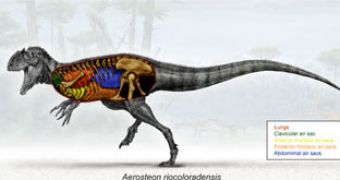Found in the Rio Colorado region of Argentina, the fossilized remains of a dinosaur called Aerosteon Riocoloradensis may aid scientists track the evolution of birds' breathing systems.
Jeffrey Wilson and his team of paleontologists from the University of Michigan took part in dinosaur specialist Paul Sereno's expedition during which a 30 foot (about 10 meter)-long meat-eating dinosaur was discovered on the banks of Rio Colorado in Argentina. The unusual feature that distinguishes the dinosaur from its ancient brethren is its respiratory system, an unprecedented finding when associated to the respective group. This further proves the theory that links dinosaurs to modern day birds.
Birds possess a distinctive, more efficient breathing system, unlike that of the rest of the animals on the planet. Instead of the common expanding lungs, they use bellow-like air sacs that pump the air through their lungs. This allows them to fly faster and higher than the regular system-using bats. Aerosteon Riocoloradensis was seemingly provided with an identical system, which even gave it its name (“air bones from the Rio Colorado”). In fact, the large predator was uncovered 12 years ago, during a 1996 expedition funded by National Geographic Society and The David and Lucille Packard Foundation, but cleaning and scanning the complete skeleton, as well as the full comprehension of the finding took quite a while.
The proof of bellow-shaped air sacs in Aerosteon's body cavity finally gives credit to the sporadic findings in other species of sauropods' backbones. Its clavicles, vertebrae and hip bones are provided with tiny openings which lead into wide, hollow spaces that were covered by a thin soft tissue layer and most likely full of air when the animal was alive. These chambers serve in the pneumatization process, a phenomenon during which the air sacs reach the bones. As Wilson explains, “In sauropods, pneumaticity was key to the evolution of large body size and long necks; in birds it was the key to the evolution of a light skeleton and flight. The ancient history and evolutionary path of this feature is full of surprising turns, the explanations for which must account for their presence in a huge predator like Aerosteon and herbivores like Diplodocus, as well as in a chicken”.
The dinosaur air sacs' evolution is explained by the researchers in a threefold theory: one presumes the development of more efficient lungs, another backs the mass reduction of the upper part of the body at two-legged runners, while the last addresses the body heat excess release. Paul Sereno is especially interested in the latter, since Aerosteon was a feather-covered high-energy carnivore which lacked birds' sweating glands. As heavy as an elephant, it may have used its underskin air system in order to get rid of the excessive heat.

 14 DAY TRIAL //
14 DAY TRIAL //